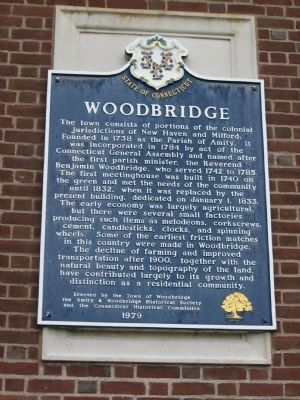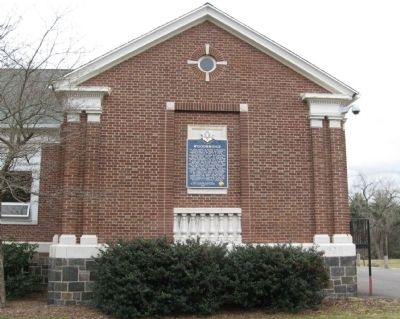Woodbridge in New Haven County, Connecticut — The American Northeast (New England)
Woodbridge
The decline of farming and improved transportation after 1900, together with the natural beauty and topography of the land, have contributed largely to its growth and distinction as a residential community.
Erected by the Town of Woodbridge
the Amity & Woodbridge Historical Society
and the Connecticut Historical Commission
1979
Erected 1979 by The Town of Woodbridge, The Amity & Woodbridge Historical Society, Connecticut Historical Commission.
Topics. This historical marker is listed in these topic lists: Colonial Era • Settlements & Settlers. A significant historical month for this entry is January 1915.
Location. 41° 21.242′ N, 73° 0.774′ W. Marker is in Woodbridge, Connecticut, in New Haven County. Marker is at the intersection of Meetinghouse Lane and Newton Road, on the left when traveling west on Meetinghouse Lane. Located on the north wall of the Old Center School which houses the police and other town departments. Touch for map. Marker is at or near this postal address: 11 Meetinghouse Lane, Woodbridge CT 06525, United States of America. Touch for directions.
Other nearby markers. At least 8 other markers are within 4 miles of this marker, measured as the crow flies. Woodbridge Veterans Monument (a few steps from this marker); VFW Bedworth Post 2871 Monument (about 300 feet away, measured in a direct line); Judges Cave (approx. 2.6 miles away); Westville Soldiers' Memorial (approx. 3.3 miles away); Anna Sewell Memorial Fountain (approx. 3.4 miles away); Elm Street School Veterans Memorial (approx. 3.4 miles away); Ansonia (approx. 3.4 miles away); American Liberty Elm (approx. 3.4 miles away). Touch for a list and map of all markers in Woodbridge.
Also see . . . Woodbridge, Connecticut on Wikipedia. (Submitted on March 24, 2010, by Michael Herrick of Southbury, Connecticut.)
Credits. This page was last revised on June 16, 2016. It was originally submitted on March 24, 2010, by Michael Herrick of Southbury, Connecticut. This page has been viewed 787 times since then and 9 times this year. Photos: 1, 2. submitted on March 24, 2010, by Michael Herrick of Southbury, Connecticut.

